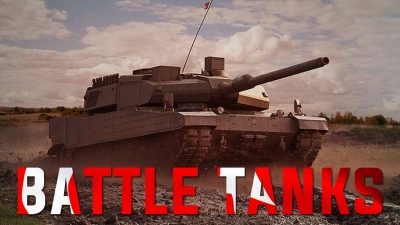Video: Turkey’s Military Industrial Complex
Army Battle Tanks: Modernization Drive

Turkey is working to develop its national industry and reequip its armed forces with modern military equipment. The worth of projects in this field is estimated to be around $77 billion. Ankara is paying special attention to the modernization and development of its tank fleet. Currently, Turkey has over 3,000 main battle tanks (MBTs), the most capable of which are the 339 Leopard-2A4 and 170 M60T Mk2 ‘Sabra’ MBTs. They are equipped with modern fire control systems and NATO standard 120mm guns.
The Sabra, known in Turkish service as the M60T, is the extremely modernized version of the American M60 Patton second-generation MBT. The upgraded package was developed by Israel’s IMI Systems for export to Turkey. The Mk2 variant, ordered under the 2020 contract ($688 million USD), includes improved armour, the specially developed MG253 120mm smoothbore gun, the M60 Patton style M19 cupola with the M85 12.7 mm machine gun, the Knight fire control system from Elbit Systems, and an MTU Friedrichshafen engine built under license in Turkey. The employed 60mm mortar system is supplied by Israeli Soltam Ltd. The Mk2 features provision for Explosive Reactive Armour. The MBTs were upgraded by the Turkish 2nd Main Maintenance Center in cooperation with Israel. All the systems, except for the armor package, were built under license with technology transfer in Turkey.
In February 2018, M60T and Leopard 2A4 MBTs started receiving the ‘Akkor Pulat’ Active Protection System, the export variant of the ‘Zaslon-L’ system developed in Ukraine, on the basis of the remaining Soviet technologies. During Operation Euphrates Shield in northern Syria (August 2016 – March 2017), the Turkish tank fleet suffered notable losses from ISIS terrorists employing various anti-tank weapons, including various second-generation anti-tank missiles. The Turkish Army actively employed its Leopard 2A4 MBTs during the battle for al-Bab. Up to 10 of them were lost. During the second military operation in northern Syria, Operation Olive Branch (January-March 2018), the Turkish Army was already using some MBTs equipped with ‘Akkor Pulat’ active protection systems. Its effectiveness in real combat conditions remains unclear to the public because Ankara adapted its approach and started relying on waves of proxy fighters supported by air power, artillery and special forces. Much fewer Turkish Army units equipped with MBTs were involved in a direct fighting.
As of January 2020, the Turkish M60T fleet had almost fully depleted its modernization potential and it’s unlikely that it will undergo any significant upgrades in the future. At the same time, the Leopard 2A4 modernization program agreed to with Germany was halted due to diplomatic contradictions between Ankara and Berlin during the operation against Kurdish armed groups in January 2018. Therefore, Turkey could opt the alternative modernization package proposed by the ASELSAN A.S. corporation – the Leopard-2NG (Next Generation). The key areas of improvement include new fire control and intelligence/battlefield management systems, upgraded optics, additional ballistic protection and mine protection modules. The L55 smoothbore gun proposed instead of the L44 employs horizontal and vertical electrical drives. Another important feature is the SARP (Stabilized Advanced Remote weapon Platform) remote-controlled weapon station with a machine gun or an automatic grenade launcher and the ATS-40 electro optic sensor system. The upgrade package would increase the MBT weight to 65t and allow it to carry additional ammunition. ASELSAN promo materials claim that the upgraded MBTs will be superior to the German Leopard 2A6 MBTs.
The Leopard-2NG program is also useful as the field test for technical solutions that could be used in the Turkish future MBT, Altay. For example, the Altay model showcased in 2018 was equipped with a turret similar to those of the Leopard-2NG. The main contractor for Altay is Otokar. However, other Turkish companies – ASELSAN (sub-systems and fire control system), MKEK (main gun system), Roketsan (armour package), Hyundai Rotem (technical support and assistance) – are also involved.
The Altay employs the MKEK-120 smoothbore gun, similar to the German Rh-120/L55. This gun is able to provide an initial velocity of the M829A2 armor-piercing tank round of approximately 1,750 m/s. This increases its armor penetration capability and firing accuracy. As a comparison, the initial velocity of the M829A2 with the L44 gun is 1,660 m/s.
In October 2019, the Altay producer company BMC announced that the Altay would enter service in 2021 and become completely indigenous by 2023. Several Altay development prototypes passed runoff and firing trials. Turkish sources claim that up to 250 Altay MBTs will enter service with the Turkish Army by 2025. The serial production of the Altay MBT will increase combat effectiveness of the Turkish Army and allow Ankara to rearm its ground forces with modern MBTs regardless of the position of its “Western allies” toward its foreign policy. This will be another demonstration of the high potential of the Turkish national defense industry which has achieved several important breakthroughs during the past decade.
*
Note to readers: please click the share buttons above or below. Forward this article to your email lists. Crosspost on your blog site, internet forums. etc.
Support South Front in its endeavors. If you’re able, and if you like our content and approach, please support the project. Our work wouldn’t be possible without your help: PayPal: [email protected] or via: http://southfront.org/donate/ or via: https://www.patreon.com/southfront

